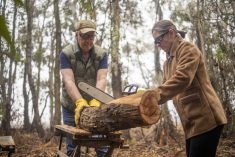Are you being gentle with yourself? Life has a way of slowly taking us off course from time to time. Often there are so many things to do, so many pressing commitments and responsibilities to family and others, that we don’t take care of ourselves.
Another great challenge is the health of our planet, Mother Earth. What would happen if thousands more Canadians really reconnected to nature?
Let’s try taking regular walks with a companion, family members or even a dog along secure pathways. Communing with what we may have overlooked could be just what the nature doctor ordered.
Read Also

Gentle treatments for pain in the neck
Heading toward year-end, people unknowingly tense up against the cold and busyness, causing neck pain that can often be treated with appropriate support and gentle mobility, athletic therapist Kathlyn Hossack says.
Have you seen any hummingbirds lately? I haven’t seen any yet as I write this in the first week of June. Nor have I seen or heard any of those vocal Jenny wrens and meadowlarks that used to be quite prevalent where I live.
Have they moved further north this year or are they in short supply? I recently heard news that some Canada geese may be going further north to nest.
I have been meaning to look back into my archives of pictures, letters and emails. Doing so has led me to focus on hummingbirds, so that’s what to expect coming up.
This reminds me of the following words from a song I wrote over 20 years ago.
Gardeners love to party, farmers love to party,
And when we’re not working hard,
We eat hale, strong and hearty,
Gardeners love to party, farmers love to party,
To sing and swing and tap our toes,
And stay out late ’til cows come home,
And for dessert eat Smarties.
Besides my Singing Gardener cap, which is similar in appearance to the once-common rail engineer’s cap, I also have several Tilley hats. I’m sure glad I’m able to wear the one with the widest brim during hot and humid summer days.
Here’s a welcome tip of my hat wherever you are across this great land. Keep reading, as you won’t want to miss what follows about hummingbirds and how to make their favourite liquid sugar water to provide them with additional nutrition.

Tiny dynamos
Let me ask — is there anything more entertaining at low cost than watching the aerobatic antics of hummingbirds?
Whether they’re visiting for a sip of sugar syrup at the bird feeder or zooming through the flower garden, you’ll often hear their whirring wings before you ever see them.
Yes, hummingbirds provide hours of enjoyment. It’s a chance to watch your own nature show outside the kitchen window or in the backyard. They are the only birds that can fly forward, backward and sideways, hover in mid-air and even turn upside down.
Many birdwatchers have a special love for hummingbirds. There’s just so much power and personality packed into these tiny dynamos of colourful feathers.
From my archives
I first heard from Leanne Mortlock on Vancouver Island about two years ago when she sent me pictures of her hummingbirds and shared experiences. She wrote:
“Hi Ted. The male Rufous hummingbird migrates north in March/April. This one (pictured on this page) doesn’t come around as much as I would like him to. The female is one of my regulars.
“Rufous males have a high pitch to their chirping, so I always know when one does come around. I find them to be a lot more timid than the Anna’s hummingbirds (pictured on this page), perhaps because the Anna’s are here all year round.
“Photographing hummingbirds in flight or perched somewhere on Vancouver Island, B.C., became my pandemic hobby and I was quickly hooked. Thank you for considering them. It’s nice to be able to use (these pictures) in some capacity rather than taking up space on my computer. I ordered and planted the hummingbird seed mix from West Coast Seeds.”

Leanne also writes, “I do make my own syrup for my feeders: four parts water to one part white sugar. I boil the water in the kettle then dissolve the sugar in it and boil on the stove for 10 minutes. Let it cool to room temperature, then fill my feeders. I wash and refill the feeders weekly to avoid any bacteria from growing.”
I also heard from another reader who agreed with Leanne’s 1:4 hummingbird sugar-water ratio and stated the following:
“It is based on similarity to nectar in flowers. Any mix made significantly sweeter can interfere with a hummingbird’s digestion. To be responsible for the health of these tiny much-loved creatures, we need to keep the syrup as close to a natural nectar as possible. When it comes to sweeteners other than white sugar, cane sugar has been used but it’s more expensive, so stick with white sugar.”
Do not, however, use honey, jelly powders, corn syrup, turbinado, molasses, brown sugar or especially artificial sweeteners in your sugar syrup. Hummingbirds burn prodigious amounts of energy for their size and need real sugar.
Do not add any red food colouring either as it is unnecessary and can harm these wee beings, even in low concentrations.
To recap — sugar syrup prepared for hummingbirds should have only two ingredients, white sugar and water, and the most favourable ratio is one cup of sugar to four cups of water.
Another thing I’ve noticed is recommended cooking times for sugar syrup appear to vary. Some say bring the mixture to a boil and continue boiling for one minute, then remove from heat to cool. Others say to boil it longer for different numbers of minutes.
Keep in mind that overheating sugar syrup can also cause more evaporation and increase the sugar concentration in it. If you wish to weigh in with your opinion and experience in this connection or anything about hummingbirds, please do so.
















